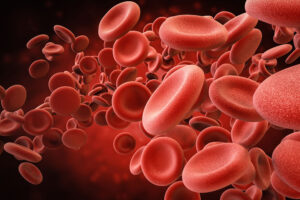
Early reports of the COVID-19 outbreak in Wuhan, China included evidence of coagulation abnormalities in some patients. Since then, studies have shown an increase in venous thromboembolism (VTE)—including deep vein thrombosis (DVT) and pulmonary embolism (PE)—in some patients with COVID-19. Higher rates of incidence have been observed in patients in the intensive care unit (ICU) than in other hospitalized COVID-19 patients.
In response to the reported increased risk of VTE, a team of clinicians at Brigham and Women’s Hospital has been giving a prophylactic anticoagulant dose of low-molecular-weight heparin (LMWH) to all hospitalized COVID-19 patients since the early days of the pandemic.
“There are a number of factors that seem to put patients at risk for coagulopathy with COVID-19,” says Jean Marie Connors, MD, a hematologist and medical director of the Anticoagulation Management Service in the Brigham’s Hematology Division. “One factor is inflammation, which drives up procoagulation proteins.”
Over the past decade, researchers have uncovered the complex relationship between inflammation and coagulation: they are mutually beneficial processes that cooperate to fight infection. Inflammation activates coagulation, which in turn walls off pathogens with blood clots.
An April study of COVID-19 patients confirmed that increased inflammation, as measured by IL-6 levels, correlates with higher levels of the procoagulant protein fibrinogen. “The cooperation of those processes, by triggering activation of coagulation, can increase risk of thrombosis,” explains Dr. Connors.
SARS-CoV-2 May Directly Infect Endothelial Cells
Other factors that increase risk of thrombosis include immobilization—common for bed-bound COVID-19 patients—and endotheliopathy, or direct infection of the vascular endothelial cells.
Research suggests that SARS-CoV-2 can directly infect the vascular endothelial cells via their angiotensin-converting enzyme 2 (ACE2) receptors, which the virus binds with to enter cells. Endotheliopathy results in disruption of natural anticoagulation mechanisms.
“The extent of endotheliopathy we’re seeing is new,” says Dr. Connors. “The reason SARS-CoV-2 is so severe may be because no one is immune to this virus, unlike, say, influenza.”
Due to high coagulation factor levels, immobilization and endotheliopathy, patients are facing increased risk of VTE, as well as arterial thrombosis and microvascular thrombosis, all of which prevent oxygen from reaching the lungs and contribute to patients’ difficulty in breathing.
“In order to improve thrombosis, you have to clear the virus,” explains Dr. Connors. “But some patients have more trouble with this than others, thus developing an exaggerated inflammatory response to infection.”
Addressing the Increased Risk of VTE Among ICU Patients
Doctors still don’t know exactly what determines a patient’s response to the virus. For instance, while hypertension and diabetes affected outcomes in China, this response has been less observed in the U.S. Dr. Connors says that a patient’s risk of thrombosis is more predictable: it typically correlates with the severity of the body’s inflammatory response to the virus.
Accordingly, several studies, analyzed in a recent paper by Dr. Connors in the journal Blood, have shown that COVID-19 patients in the ICU are at increased risk of having a venous blood clot — and that the incidence of VTE is even higher than historic ICU rates.
“This may be because patients in the ICU have higher levels of the inflammation,” says Dr. Connors. “The more severe the inflammatory reaction to the virus, the more abnormal the clotting parameters are, and the higher the risk for getting blood clots and developing microvascular thrombosis.”
Due to the high rates of occurrence, the clinical team recognized the urgency and took action. Based on data that higher anticoagulation doses can improve efficacy, Dr. Connors recommended in mid-April that the Brigham increase the prophylactic dose to intermediate-intensity anticoagulation for patients in the ICU. This decision was preceded by a similar approach used by clinicians in the Netherlands.
Dr. Connors is now collaborating with others to finalize the protocol for a randomized control trial that will study the ideal anticoagulation dosage.
Ensure Consistency by Working Collaboratively
According to Dr. Connors, the staggering number of COVID-19 patients early in the pandemic exposed trends of complications like VTE and it was challenging to care for so many patients at once.
During the early stages, Brigham specialists created a standardized living document, COVID Clinical Guidelines, to incorporate rapidly-changing medical recommendations and keep everyone on the same page in their COVID-19 response. It’s become a valuable reference tool for other hospitals and organizations.
“Because so many different types of physicians are caring for COVID-19 patients and it may not be their usual day job, it’s been important to have a manual on how to take care of these patients,” says Dr. Connors. “The COVID-19 protocols allow everyone to work cooperatively to make sure patients get the best care.”